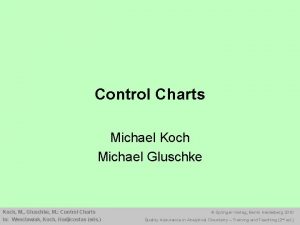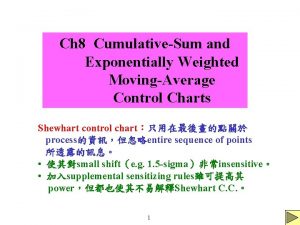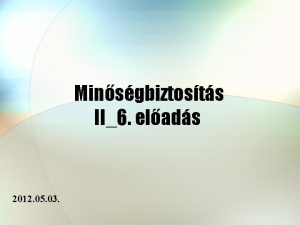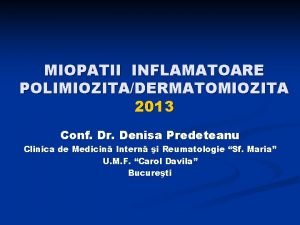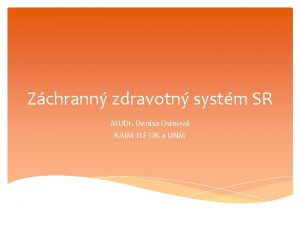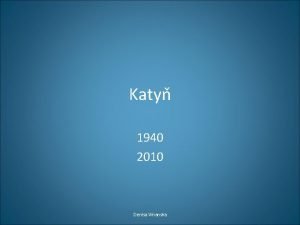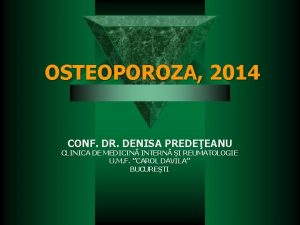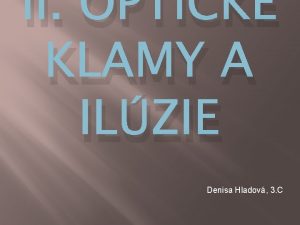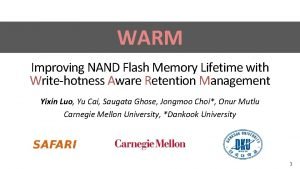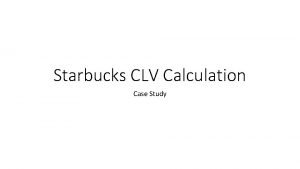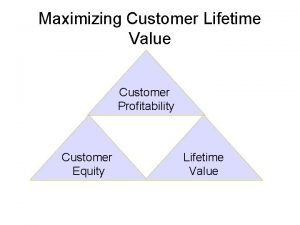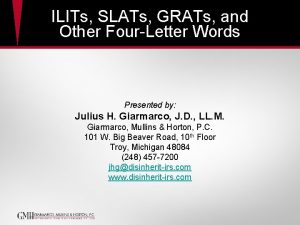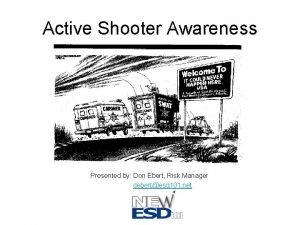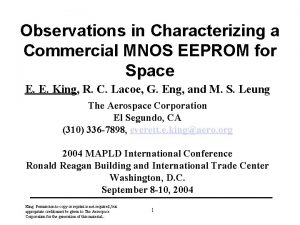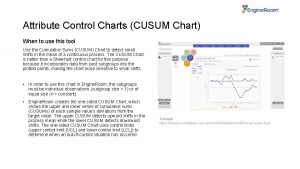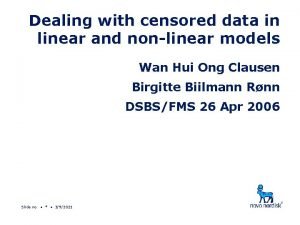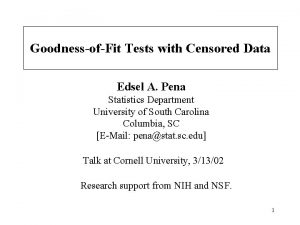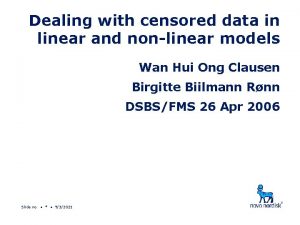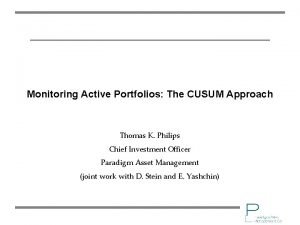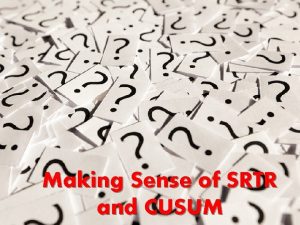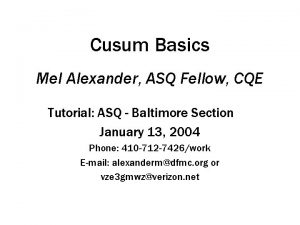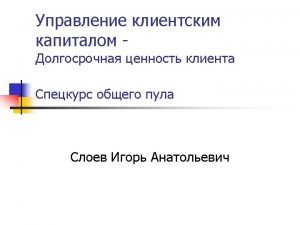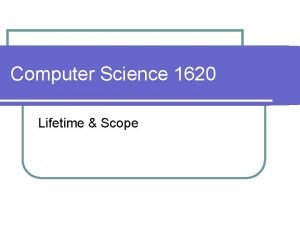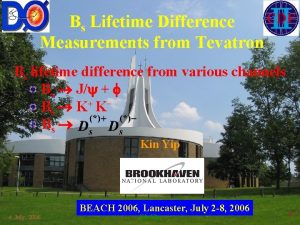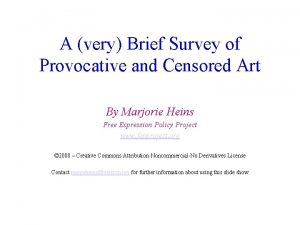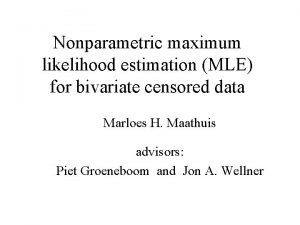CUSUM Charts for Censored Lifetime Data Denisa A
























- Slides: 24

CUSUM Charts for Censored Lifetime Data Denisa A. Olteanu Virginia Tech Quality and Productivity Research Conference June 3 rd , 2009

Content ¡ ¡ ¡ Intro Data Probability Distributions for Lifetimes CUSUM Charts for Lifetimes Conclusions

Introduction ¡ Reliability is the ability of a system to perform a required function under stated conditions for a stated period of time. Quality Control Early detection of faults with a monitoring program would allow for repairs to be performed in situations at much less expense. ¡ Life Tests Companies put n items on a test stand perform life tests, often under accelerated conditions.

Censoring ¡ Right-Censoring l l ¡ Left-Censoring l ¡ Type I: test stops after a certain time Type II: test stops after a certain number of failures are recorded Item fails before first inspection Interval Censoring l When one records times through periodic inspection

Distributions for Lifetime Data Typically Non-Normal ¡ Most Popular: ¡ l l Weibull Lognormal Exponential Multinomial

0, 03 Weibull Distribution Effect of the Shape Parameter for η = 100 0, 025 0, 02 f(t) β =. 5 (Early Failure) 0, 015 β = 1 (Random Failure) β = 3 (Wear Out) 0, 01 β = 5 (Rapid Wear Out) 0, 005 0

The Weibull Distribution and Relationship to SEV ¡ Probability distribution function for the Weibull distribution: ¡ Then Y=log(T) follows a Smallest Extreme Value (SEV) distribution with:

Log-Normal and Other Distributions ¡ If T has a log-normal distribution with parameters μ and σ, then Y=log(T) is normally distributed with mean μ and standard deviation σ, and the normal theory applies ¡ For interval censoring, the counts of failures in each interval have a multinomial distribution ¡ Other distributions: exponential as a particular case of the Weibull with shape parameter 1

The Likelihood Function ¡ General form of the likelihood function for any distribution and including right-censoring: ¡ Maximize it to get parameters’ estimates ¡ Use it to construct likelihood ratio tests

Construction of Likelihood Function for Weibull Data, using the SEV transformation ¡ Log-likelihood function: Uncensored Case ¡ Log-likelihood function: Right-Censored Case

Monitoring Needs ¡ Interest in monitoring for changes in the parameters of the usually non-normal distributions used in Reliability (focus on Weibull) ¡ Different types of censoring patterns present (focus on right-censoring) ¡ Searched literature for monitoring methods of interest

In the Literature: Monitoring Lifetimes ¡ Approaches: l Conditional Expected Value (CEV) methods l Monitoring for changes in small percentiles of interest l Methods based on likelihood ratio tests l Other methods ¡ Shewhart-type charts for uncensored data, with only one parameter changing and CEV-based methods monitoring for shifts in mean are predominant

In the Literature: CEV Methods ¡ Underlying CEV approach, independent of the distribution used l Weights replace right-censored data points, weights determined as: where and C is the censoring time

CEV Methods: Examples ¡ Steiner and Mac. Kay (2000) developed and recommended the use of the Extreme Value CEV Shewhart-type chart for grouped right-censored data l l ¡ They monitor for decreases in the mean of the Weibull distribution, that models lifetimes; the shape parameter is fixed They use the SEV transformation and plot the sample averages of the transformed data, with censored points replaced by the CEV weights Zhang and Chen (2004) constructed a EWMA chart for monitoring the mean of censored Weibull lifetimes using CEV approach

CUSUM chart development for Lifetimes ¡ Cases considered: - Uncensored data - Right-censored ¡ ¡ Underlying distribution: Weibull Positive or negative shifts in the scale parameter, η

General frame: CUSUM chart based on the sequential probability test approach ¡ Samples of n lifetimes are collected from the process ¡ We consider a Weibull distribution for our lifetime data ¡ We use the SEV transformation ¡ The in-control values (under the null hypothesis that the process is in control) for our parameters of interest are given, or estimated from in-control historical data using MLE ¡ The shift to an out-of-control situation in the parameter of interest is defined by giving an out-of-control (alternative hypothesis) value for the parameter

General frame: CUSUM chart based on the sequential probability test approach ¡ Cumulative Sum (CUSUM) charts: l Generally superior to traditional Shewhart charts ¡ Likelihood Ratio Tests: l Prominence as measure of statistical evidence in hypothesis testing, sequential sampling, and development of CUSUM charts l Accommodate different underlying distributions l Accommodate censoring

General frame: CUSUM chart based on the sequential probability test approach ¡ The CUSUM chart plots where and y(i) is the i-th sample of n log-lifetimes ¡ The chart signals when S crosses a threshold found through simulations

Uncensored case, Chart for the Scale Parameter o The test statistic becomes:

Right-Censored Case, Chart for the Scale Parameter o The test statistic becomes:

Properties: Simulation Results ¡ CUSUM chart for monitoring the scale parameter eta, beta fixed, uncensored case: - Sample size=Number of failures=20 - Beta=0. 5 - In-control eta=1 - Shift d=0. 5, out-of-control eta=0. 5 - Number of simulation replications=1000 - Number of generated samples=1000 - Chart threshold=4. 56 - Out-of-control ARL=4. 88, simulation error=0. 005 - In-control ARL=378, simulation error=7

Properties: Simulation Results ¡ CUSUM chart for monitoring the Scale parameter eta, beta fixed, right - censored case: - Sample size=20 - Number of failures=15 - Beta=0. 5 - In-control eta=1 - Shift d=0. 5, out-of-control eta=0. 5 - Number of simulation replications=1000 - Number of generated samples=1000 - Chart threshold=1. 22 - Out-of-control ARL=11. 2, simulation error = 0. 03 - In-control ARL=385, simulation error=7

CUSUM Chart

Conclusions ¡ SPRT-based CUSUM Charts for Non-normal distributions and Censored data should bridge the gap between Reliability and Quality Control fields ¡ The existing methods in the literature for monitoring lifetimes predominantly focus on uncensored data, Shewhart-type charts, and monitor for the mean, while reliability professionals usually focus on individual parameters
 Cusum control chart excel
Cusum control chart excel Cusum chart
Cusum chart Cusum
Cusum Vzor vysvedčenie
Vzor vysvedčenie Dr denisa predeteanu contact
Dr denisa predeteanu contact Mudr denisa osinova
Mudr denisa osinova Denisa vinanska
Denisa vinanska Denisa osinova
Denisa osinova Denisa vinanska
Denisa vinanska Dr denisa predeteanu
Dr denisa predeteanu Tamara ionescu
Tamara ionescu Denisa gottvaldova
Denisa gottvaldova Denisa červenková
Denisa červenková Youth comes but once in a lifetime
Youth comes but once in a lifetime Flash memory lifetime
Flash memory lifetime Customer lifetime value case study
Customer lifetime value case study Enhanced limited lifetime warranty
Enhanced limited lifetime warranty Maximizing customer lifetime value
Maximizing customer lifetime value Slat vs grat
Slat vs grat Don ebert
Don ebert Usaa lifetime fitness
Usaa lifetime fitness Eeprom lifetime
Eeprom lifetime Storage binding and lifetime
Storage binding and lifetime Get tombstone lifetime powershell
Get tombstone lifetime powershell Kappa alpha psi membership card
Kappa alpha psi membership card
